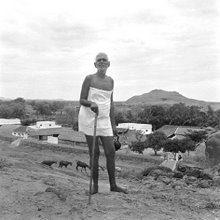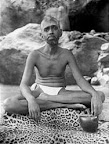A little after Alagamma left the Maharshi at Pavalakundru her son Nagaswami who was then in his prime passed away in 1900, leaving behind a childless widow. Alagamma's grief was immense - by then she had lost her husband and eldest son ; her second son was a sannyasi and her third son was barely fourteen. Yet he took on the family responsibility and joined the Tiruvengadu temple as a clerk. In 1902 he visited his brother at Arunachala and on seeing him broke down. But the elder one was as usual unmoved. Alagamma depended on her husband's brother Nelliappa Iyer for sustenance.
She had a painful time and spent most of her time reciting vedantic songs. Like several ladies of her time she was able to sing well though she was not formally trained to do so. She made it a point to learn the import of great vedantic sayings, the mahavakyas, from an elderly lady, Tulasi. Thus she consoled herself and was peaceful.
In 1913, she went on a pilgrimage to Kasi and on her way back halted at Arunachala.
A little later Nagasundaram got married and set up house. Alagamma stayed with him. The family finances were none too comfortable; the house at Tiruchuzhi had to be sold in 1900 to clear debts. Nelliappa Iyer passed
away in 1914. In the same year Alagamma once again went on a pilgrimage. This time it was to Tirupati. On her way back she visited her son at Arunachala, who was then staying at the Virupaksha cave.
During her brief stay Alagamma had an attack of typhoid. The Maharshi who was quite indifferent about his own body took great care in nursing his mother. In fact he did so even when his disciples or visitors fell ill.
Alagamma had high temperature and therefore had delirium. Thereupon the Maharshi composed four verses addressing Arunachala . These were the verses:
1. Hill of my refuge that cures the ills of recurring births! Oh Lord! It is for thee to cure my mother's fever.
2. Oh God that smitest Death itself ! My sole refuge! Vouchsafe Thy grace unto my mother and shield her from Death! What is Death if scrutinised?
3. Arunachala! Thou blazing fire of Jnana! Deign to wrap my mother in Thy light and make her one with Thee. What need then for cremation?
4. Arunachala! That chasest away illusion ( Maya)!
Why delayest Thou to dispel my mother's delirium? Besides Thee is there anyone who with maternal solicitude can protect the suppliant soul and ward off the strokes of destiny?
— Translation: Collected Works
As the Maharshi said, how could Alagamma who was destined to be merged in the fire of Jnana, be cremated?
The fever subsided. As she did not like the idea of being a burden on the ashram Alagamma returned to Manamadurai. In 1915, Nagasundaram's wife
Mangalammal, passed away suddenly leaving behind her only son, an infant, Venkataraman. The baby's care became a problem. Initially Nelliappa Iyer's wife undertook the responsibility but as she was also getting on in years, Nagasundaram left the boy in the care of his sister, Alamelu.
Staying at home became unbearable for Alagamma.
She looked around but could discern nobody other than her second son, the Maharshi, with whom she could stay. In fact it was he who could be her saviour both in the here and the hereafter. Alagamma left for Arunachala (1916) and initially stayed with Echammal. But she wanted to stay at the ashram with her son. But the ashram was too small to accommodate her also. Besides, some of the Maharshi's disciples such as Gambhiram Seshayya felt that if the Maharshi were to have the company of his close relatives he might again leave everybody and go away from Arunachala itself; hence they objected to the mother's stay at the ashram. As she could find no other alternative Alagamma returned home to pursue her abhyasa of yoga. Yet she was not quite happy.
A little later she again went on a pilgrimage to Tirupati, accompanied by Nagasundaram and his baby son. On their way back they halted at Arunachala and this time Alagamma decided to stay back at the ashram. The disciples of the Maharshi also relented.
A little after the arrival of the mother at the ashram
the Skandasramam got ready and the Maharshi moved there. Alagamma followed him. Nagasundaram and his son returned to Tiruvengadu.
Nagasundaram had his share of difficulties right from his young days. He had suffered from a host of ailments in his childhood. To cap all his other difficulties he had the huge burden of debt. Unable to bring up his son he left him elsewhere.
During that period Narayana Reddy of Arunachala visited him and conveyed to him the desire of Alagamma that both her sons should be by her side. Hence Nagasundaram left for Arunachala but as he was aware that his brother, the Maharshi, was not particularly attached to anybody Nagasundaram stayed with Gambhiram Seshayya for sometime and kept visiting the Maharshi like any other devotee.
In 1918, Nagasundaram took to sannyasa [?] and donned the ochre robes. As a renunciate he took the name Niranjanananda. He would beg for his food in the town, a practice which the Maharshi's disciples did not appreciate. After all, while they were all partaking of the food offered to Bhagavan by his devotees it was incongruous that the Maharshi's brother should go out abegging. Meanwhile, Alagamma organised a kitchen at the ashram. The young sannayasi, Niranjanananda, did not have to go out seeking alms thereafter.
In this manner the Maharshi became some kind of a householder. His disciples constituted his family, his close relatives were with him and a permanent residence where food was cooked had sprung up.
It is appropriate to recall here what Seshadri Swami said to a devotee of his who sought his permission to go
up the hill (to have Bhagavan's darshan). Seshadri laughed and said, "Go, by all means go. You have a householder there, he will give you sweets also". This statement was pregnant both with a practical (vyavaharika) and absolute (paramarthika [?]) meaning.
Referred Resources:
Tiruchuzhi
Links to letters:
Echamma: (Chapter 15: Echamma’s Demise
Maya: (Chapter 91: Maya (Illusion)
Alagamma: (Chapter 102: Mother Alagamma
childhood: (Chapter 259: Boyhood Days
Links to rl:
Nelliappa Iyer: (Chapter 16: Victorious Yoga
Virupaksha: (Chapter 18: The Peerless Hill
Seshadri: (Chapter 25: Seshadri Swami
Seshadri: (Chapter 29: Giripradakshina
Alagamma: (Chapter 32: The Mother's Nirvana
Alamelu: (Chapter 45: What Next ?
1915: (Chapter 27: Sri Ramana Gita
1900: (Chapter 19: Commencement of Instructions
Echamma: (Chapter 21: Echammal
Echamma: (Chapter 40: Withdrawal of the Manifestation
Gambhiram: (Chapter 19: Commencement of Instructions
Links to sp:
Links to gems:
renunciation: (Chapter 10: Renunciation
Maya: (Chapter 2: The Self and Non-Self
destiny: (Chapter 11: Fate and Freewill






No comments:
Post a Comment